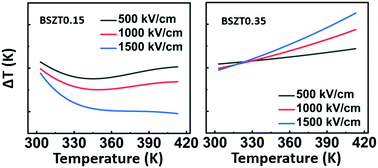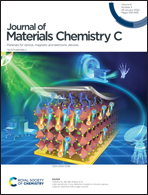Composition-driven inverse-to-conventional transformation of electrocaloric effect and large energy storage density in strontium modified Ba(Zr0.1Ti0.9)O3 thin films
Abstract
In this work, (Ba1−xSrx)Zr0.1Ti0.9O3 (BSZTx, x = 0, 0.15, 0.25 and 0.35) thin films were successfully deposited on La0.7Sr0.3MnO3 (LSMO)-coated (001) SrTiO3 (STO) single crystal substrates using laser molecular beam epitaxy. The BSZTx thin films with compositions of x = 0 and 0.15 display an inverse electrocaloric effect (ECE) with a maximum adiabatic temperature change of ΔT ∼ −10 K under 1500 kV cm−1, while a large positive ΔT amounting to ∼13 K is discovered in the strontium rich composition, i.e. x = 0.35. For the composition of x = 0.25 where weak ECE (|ΔT| < 2 K) is discovered, an energy storage density of 15.5 J cm−3 with an efficiency of 69.8% is observed in the temperature range of 303–413 K. The composition-tunable electrocaloric effect and large energy storage density with excellent thermal stability in strontium modified Ba(Zr0.1Ti0.9)O3 thin films are ascribed to the synergistic effects of different dynamics of polar nano-regions (PNRs) and conformed defect dipoles  under large electric fields at elevated temperatures. This work will facilitate the development of novel solid-state cooling devices and provide a design route for high energy storage density devices.
under large electric fields at elevated temperatures. This work will facilitate the development of novel solid-state cooling devices and provide a design route for high energy storage density devices.



 Please wait while we load your content...
Please wait while we load your content...